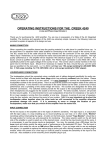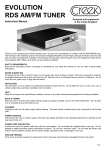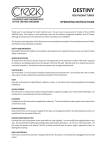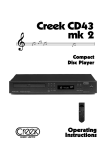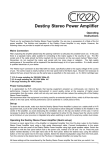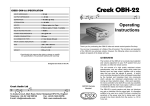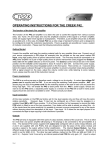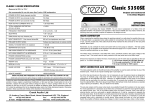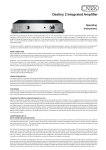Download Operating Instructions
Transcript
Operating Instructions Thank you for purchasing the 5250 amplifier You are now in possession of a State of the Art Integrated Amplifier The functions and operation of the 5250 and Special Edition are exactly the same and are very simple However the following notes are provided to explain all aspects of its design and use MAINS CONNECTION When unpacking the amplifier please keep the packing material in a safe place for possible future use In the pack there is a separate mains cable suitable for connecting to the mains supply in the country of use The IEC socket end of the cable should be firmly inserted into the connector on the rear panel marked "Mains Input’ Remember do not overload the mains wall socket with too many plugs or adaptors The high quality performance of the amplifier will be impaired if the electrical supply to it is in poor condition If in doubt consult a qualified electrician or your dealer The Mains Input’ connection is also fitted with a fuse specifically suited to the supply voltage of the country of use The correct value is clearly marked on the rear panel next to the Mains Input Should it be necessary to replace the fuse ensure that you use the same type as specified on the rear panel i e 5 x 20mm cartridge type: T 3.15 A surge resisting for 220-240V 50Hz AC, T 6 3 A surge resisting for 110120V 60Hz AC or an T 8A surge resisting for 100V (Japan) LOUDSPEAKER CONNECTIONS The loudspeakers should be connected using a suitable pair of cables designed specifically for audio use. Two pairs of screw terminals marked ’A’ allow for either bare wire or spade lug connectors to be passed through the hole or around the bush. Tighten the terminal fully after fitting the speaker wire. Please consult your dealer for advice if you are unsure. It is very important to connect the loudspeakers to the loudspeaker terminals in the correct phase. Cables are normally polarised with a line or a raised bump on the positive side. If one channel is not connected in the same fashion as the other, a severe loss of bass performance and a spreading of the stereo image will result. A second set of terminals marked ’B’ allow the user to select from the rotary control in the centre of the front panel, the option of having two pairs of speakers running separately, or together. The options include speakers off, when using headphones, speakers A, speakers B and speakers A and B together. It is not recommended to use loudspeakers of less than 40 resistance or more than two pairs of 80 speakers running from the amplifier at one time. However, bi-wiring of one pair of speakers, using the four terminal posts, can improve the sound of your system (consult your dealer for more details). M.B. It is VERY IMPORTANT not to short the loudspeaker cables together when the other ends are still connected to the amplifier, otherwise permanent damage can result. If it is necessary to move or change the location of your loudspeakers, make sure that you switch off the amplifier from the mains first. INPUT CONNECTION AND SWITCHING On the 5250 all six line inputs, including the tape input, have zero gain (passive circuitry), which can, if required, be increased by installing a Creek 5350 line stage pre-amp. The tape input is in a loop with the tape output, enabling you to record anything you can hear, or in other words, Monitor recordings without interrupting the signal. The rotary selector switch on the left-hand side of the amplifier is used to select and listen to any of the desired inputs. The second rotary selector switch on the 5250, marked Record, allows you to record any input independent of the input you are listening to. As all the line input levels are the same, it is not necessary to use the precise inputs as designated. You may, for example, plug a CD player into the Tuner input and obtain exactly the same result and performance as the dedicated CD input. For added flexibility, the first input on the 5250 can be used either for vinyl Disc or Auxiliary Line. An optional low noise MM orMC Phono Amplifier Module is available, which replaces the standard passive Link pcb, internally. Check with your dealer for more details if required. OUTPUT SWITCHING Two pairs of speakers and one pair of headphones can be selected from the knob in the middle of the front panel, marked Speakers. For listening through the headphones without loudspeakers, select Off. If one pair of speakers is required, select position A or B, depending on which sockets have been used on the rear panel. In this way two pairs of speakers can be selected together or separately. VOLUME LEVEL The volume control, situated on the right hand side of the front panel, is used to alter the relative level of the sound output from the amplifier. The volume control is necessary to adjust the level from one piece of equipment to another. It does not increase the power of the amplifier and if it is found necessary to have the volume control set to a position which is considered to be high, before the desired level of volume is obtained, it does not necessarily mean that the amplifier is having to work "flat-out". If more sensitivity is required, you may need to install a line stage pre-amp. OPERATING THE 5250 Make sure that the unit is on a suitable table, shelf or Hi-Fi equipment cabinet. It is important to allow adequate ventilation to the heatsink in the centre of the unit. Avoid obstruction of the ventilation slots on the top and bottom of the amplifier. It may be necessary to place the amplifier on the top of other equipment to allow for this. Always have the volume control set at minimum (counter-clockwise) when switching on and off, to avoid any sudden loud noises. Select the desired input on the rotary selector and switch on the amplifier with the push button marked Power on the right hand side of the front panel. Adjust the volume gently and settle down to listen. Your 5250 amplifier is designed to give you years of reliable use. If you need more assistance, it is always advisable to go back to the supplying dealer for his expert help. If you are unfortunate enough to need service work to be carried out on your amplifier, it should be returned to your dealer in the original packing material if possible. REMOTE CONTROLLED VERSION (5250R & 5250SE) The 5250R and 5250SE front panel controls function in exactly the same way as the standard 5250. The Creek Amplifier Remote Control handset allows the user to operate the volume control, input selection and mute by an infra-red (RC5) link. The bottom three buttons on the handset are for motorised volume up + down, plus mute functions. The buttons marked 1 Phono to 6 Tape are for selecting the desired source via a motorised version of the rotary input selector. Handset buttons 7, 8, 9 & 0 are not used on the 5250. When the 5250R or the 5250SE are first switched on, the power LED will glow yellow until the protection circuit confirms everything is OK. The LED will then turn green and, if selected, the loudspeaker relays will click on. Volume changes will cause the Power LED to flash green. Pressing the mute button will cause the LED to turn yellow. Pressing the button again or increasing the volume will un-mute the amp and the LED will turn green again. Adjusting the volume downwards by remote will not un-mute the amp. Please note, muting can only be cleared by the remote handset or by pressing the amplifier power switch off for 10 seconds and on again. If the amplifier stops working and the Power LED turns red, it indicates a fault. Return the amplifier to the supplying dealer for inspection. H.B. The 5250 is designed to work properly in normal domestic operating conditions. However, the amplifier’s performance may be seriously affected if sited near to, or in the room with, a radio transmitter such as a mobile phone or CB radio rig, etc. Re-siting the 5250 or the radio will normalise the situation. CREEK 5250 & 5250SE SPECIFICATION POWER OUTPUT (both channels) STANDARD 50 Watts into 8 Q POWER OUTPUT (one channel) 60 Watts into 8 Q SE 60 Watts 70 Watts Not recommended for use into more than two pairs of 8 n loudspeakers. OUTPUT CURRENT (auto current limited) > 20 Amps TOTAL HARMONIC DISTORTION (20 Hz to 20 kHz) FREQUENCY RESPONSE < 0-05% 3 Hz to 25 kHz < 0.05% -1 dB SLEW RATE > 50 V per uS INPUT SENSITIVITY (with +3dB setting selected on pre-amp) PRE-AMP OUTPUT LEVEL 450 mV line input 600 mV 5k ohms > 25Amps 470 mV 660 mV 5k ohms SIGNAL TO NOISE RATIO (’A weighted) > 105 dB SEPARATION (line inputs) > 60 dB at 1 kHz MM PHONO SENSITIVITY AND IMPEDANCE 3.5 mV 47k ohms (when fitted) MC PHONO SENSITIVITY AND IMPEDANCE 0.75 mV k ohms (when fitted) POWER CONSUMPTION (at idle) 45 W 65 W POWER CONSUMPTION (full power 10% THD) 260 W 340 W WEIGHT 7kgs, 15.5lbs SIZE 420 x 60 x 280 mm, 16-5" x 2-4" x 11" MAINS VOLTAGE @ 60Hz 100V Japan, 115V North America @ 50Hz 230/240V Europe, Asia and UK MAINS VOLTAGE @ 60Hz 100V Japan, 115V North America Designed and made in the UK. 2 Bellevue Road, Friern Barnet; London N113ER, England Tel: + 44 (0)20 - 8361 4133 Fax: + 44 (0)20 - 8361 4136 E-mail: [email protected] Internet: www.creekaudio.co.uk




